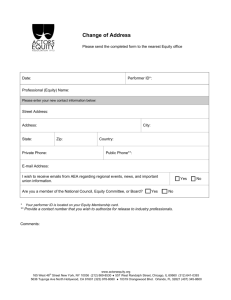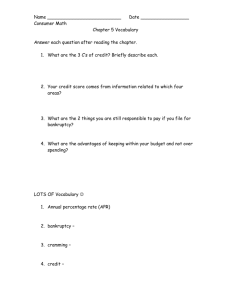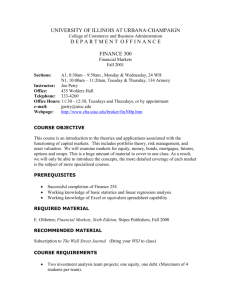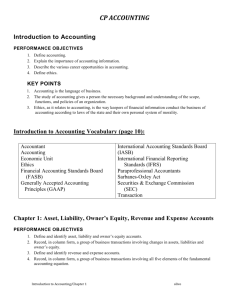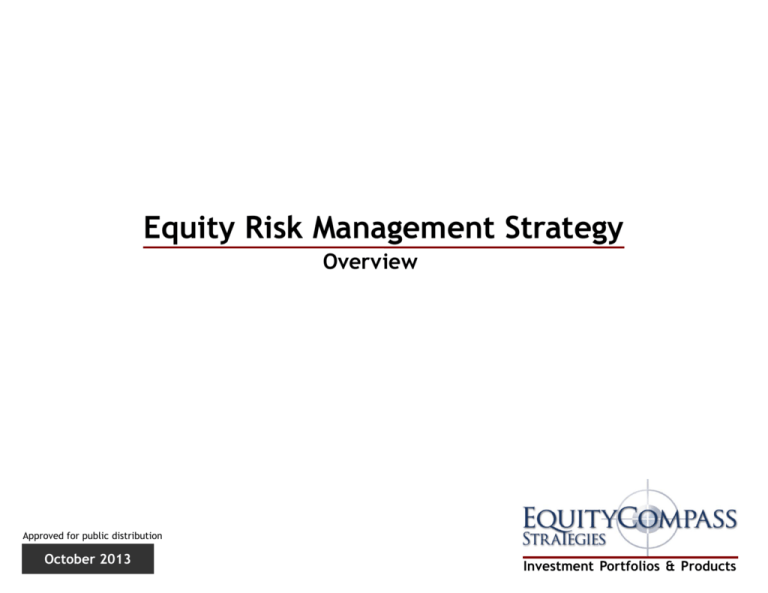
Equity Risk Management Strategy
Overview
Approved for public distribution
October 2013
Investment
Advisory
Services
Investment Portfolios & Products
Equity Risk Management Strategy*
Tactical allocation strategy that seeks to adjust a portfolio’s
portfolio s equity exposure to potentially provide downside protection and volatility
control without curtailing the upside
Incorporating the Risk Manager involves carving out a portion of an equity portfolio for tactical allocation (could range from one-third to a
maximum of 50% of the portfolio)
All Equity Portfolio
All Equity Portfolio Incorporating Risk Manager
100%
The tactically allocated portion helps
manage
g the portfolio’s
p
exposure
p
to equity
q y
markets
Tactical allocation would be fully
invested in equities when market
conditions are favorable
When conditions are deemed
unfavorable, tactical allocation is
shifted to cash or inverse (short)
1800
S&P 500
90%
1600
80%
Rissk Manager Allocation
Tactical Equity
(Risk Manager)
Stocks
100% Stocks
1200
60%
1000
50%
40%
600
30%
400
20%
200
Long Equities
Short (Inverse) Equities
Cash
100% S&P 500
800
0%
Dec‐99 Dec‐00 Dec‐01 Dec‐02 Dec‐03 Dec‐04 Dec‐05 Dec‐06 Dec‐07 Dec‐08 Dec‐09 Dec‐10 Dec‐11 Dec‐12
October 2013
1400
70%
10%
Key Benefits
Current Allocation
Protection from equity market downside risks
Volatility control
Maintain the ability to participate in enduring market advances
0
S&P 500
Investors’ emotional response to market volatility can
lead to ill-timed investment decisions
Risk Manager seeks to reduce portfolio volatility and
provide protection from extended market declines,
helping investors to stay invested during periods of
market turbulence
Investment * Model changes prior to May 2009 are based on the retroactive application of a rules set to data that was available at that time. There are inherent
limitations with the use of back-tested results, including that the results depicted may not involve market risk. No implication should be drawn that these
Advisory
results are indicative of EquityCompass’ skills, or that similar investment results have occurred or will occur in the future. Please review the important
Services
complete disclosures at the end of this presentation.
2
Equity Risk Management Strategy –
How it Works
Equity Risk Management Strategy analyzes technical and fundamental indicators to determine the current market condition and
recommends the appropriate tactical allocation
Status of Technical and
Fundamental Indicators
Market Condition
Assessment
g Action
Risk Manager
Favorable
Fully Invested
Tactical Equity Allocation:
Equities
Either fundamental OR technical
conditions are negative
Caution
Reduce Equity Exposure
Tactical Equity Allocation:
Cash
Both Fundamental AND technical
conditions are negative
Unfavorable
Hedge Equity Exposure
Tactical Equity Allocation:
Short (Inverse) Equities
Earnings expectations
(fundamentals) rising
Technical conditions positive
Portfolio Allocation
For additional details on the Equity Risk Management Strategy, please refer to the EquityCompass white paper available from your Stifel Nicolaus Financial Advisor.
Investment
Advisory
Services
3
Equity Risk Management Strategy –
See it Work
Risk Manager(1)Tactical Allocation History
Source: EquityCompass
Dec 31, 2007 – Sept. 30, 2013 | Tactical allocation altered 20 times
1
2
3
Dec.
Jan.
2007
2008
100%
Long
100%
Cash
Feb.–
Apr
Apr.
2008
90%
Short +
10%
Cash
4
5
May
Jun.
2008
2008
100%
Cash
90%
Short +
10%
Cash
6
7
July –
8
Sep.-Oct. Nov.–Dec.
Aug
Aug.
2008
40%
Cash +
60%
Long
9
10
11
Jan.
Feb.-Mar.
April
12
13
15
14
16
May –Jun. July –Aug. Sep.–Oct. Nov. ‘09- Jan.-Aug.
17
18
Sep.
Oct.
2008
2008
2009
2009
2009
2009
2009
2009
Dec. ‘10
2011
2011
2011
90%
Short +
10%
Cash
100%
Cash
100%
Cash
90%
Short +
10%
Cash
100%
Cash
90%
Short +
10%
Cash
40%
Cash +
60%
Long
100%
Long
95%
Long +
5%
Cash
100%
Long
100%
Cash
55%
Short +
45%
Cash
19
20
21
Nov. –
Jan.-
Aug.-
Oct
Dec
Dec.
Jul
Jul.
Sep
Sep.
2012-
2011
2012
2012
Present
100%
Cash
100%
Long
100%
Cash
100%
Long
22
Impact of Tactical Allocation Changes on Performance*
Growth of $10,000 | Dec 31, 2007 – Sept. 30, 2013| Risk Manager results are simulated and net of annual fees of 1.9% | Monthly data |Includes Dividends | Source: EquityCompass, Bloomberg
Tactical allocation changes helped reduce the impact of the bear market declines of 2008 thus benefiting the Risk Manager
A hypothetical
h
h
l investment in the
h Risk
k Manager outperformed
f
d the
h S&P 500 b
by 25% since Jan. 2008
Equity Risk Manager
$16,307
$18,000
16
$16,000
10
$14,000
8
$12,000 1
2 3
$10,000
4
5 6
7
9
11
12
13
14
15
17
18 19
20
21
22
S&P 500 Index
$13,009
$8,000
$6 000
$6,000
$10,000
$
,
Initial Investment
$4,000
Dec-07 Mar-08 Jun-08 Sep-08 Dec-08 Mar-09 Jun-09 Sep-09 Dec-09 Mar-10 Jun-10 Sep-10 Dec-10 Mar-11 Jun-11 Sep-11 Dec-11 Mar-12 Jun-12 Sep-12 Dec-12 Mar-13 Jun-13 Sep-13
For illustrative
ll
purposes only.
l Past performance
f
should
h ld not and
d cannot b
be viewed
d as an indicator
d
off ffuture performance.
f
Please
l
see important disclosures
d l
regarding
d
performance
f
on page 8.
(1) Equity Risk Manager is an investment that follows the Equity Risk Management Strategy by being invested in the S&P 500 when market conditions are deemed favorable, in cash when market conditions call for caution, and short
(inverse) the S&P 500 when conditions are unfavorable
* Prior to May 2009, the simulated results presented do not represent the results of actual trading of client assets, but were achieved by means of the retroactive
Investment
application of a rule set to data that was available in a prior period. There are inherent limitations with the use of back-tested results, including that the results
Advisory
depicted may not involve market risk. No implication should be drawn that these results are indicative of EquityCompass’ skills, or that similar investment results
Services
have occurred or will occur in the future. Please review the important complete disclosures at the end of this presentation.
4
Equity Risk Management Strategy
Performance
Cumulative Returns*
Dec 31, 1999 – Sept. 30, 2013 | Simulated results of Risk Manager net of annual fees of 1.9% | Monthly data |Includes Dividends
Equity Risk Manager
123 3%
123.3%
50% S&P 500+
50% Risk Manager
95.8%
S&P 500
48.4%
S&P 500
Equity Risk Manager
50% S&P 500 +
50% Risk Manager
Cumulative Return
48.4%
125.3%
95.8%
A
Annualized
li d R
Return
t
2 9%
2.9%
6 0%
6.0%
5 0%
5.0%
15.7%
12.7%
10.5%
0.10
0.37
0.34
Std. Deviation
Calendar Year Returns*
Sharpe Ratio
Dec 31, 1999 – Sept. 30, 2013 | Simulated results of Risk Manager net of annual fees of 1.9% | Monthly data |Includes Dividends
S&P 500 Index
Equity Risk Manager
40.0%
29%
24%
19%
20.0%
11%
11%
16% 14%
8%
8%
5%
5%
15%
26%
9%
8%
8%
2%
4%
3%
16%
12%
0.0%
-9%
-20.0%
-12%
-15%
-22%
-37%
-40.0%
2001
2002
2003
2004
2005
2006
2007
2008
2009
2010
2011
(1) 50% S&P 500 and 50% Risk Manager
For illustrative purposes only. Past performance should not and cannot be viewed as an indicator of future performance. Please see important disclosures regarding performance on page 8.
2012
2013YTD
Source: EquityCompass, Bloomberg
* Prior to May 2009, the simulated results presented do not represent the results of actual trading of client assets, but were achieved by means of the retroactive
Investment
application of a rule set to data that was available in a prior period. There are inherent limitations with the use of back-tested results, including that the results
Advisory
depicted may not involve market risk. No implication should be drawn that these results are indicative of EquityCompass’ skills, or that similar investment results
Services
have occurred or will occur in the future. Please review the important complete disclosures at the end of this presentation.
5
Equity Risk Management Strategy –
Key Differentiators
Downside Protection Without Curtailing the Upside
Risk Manager is not a permanent hedge. It seeks to reduce equity exposure only during periods of unfavorable market conditions. When conditions
return to being favorable, the strategy reverts to being fully invested in equities
Enables Investors to Stay Invested During Periods of Market Turbulence
Investors’ emotional response to market volatility can lead to ill-timed investment decisions. Risk Manager seeks to reduce portfolio volatility and
provide protection from extended market declines, helping investors to stay invested during periods of market turbulence
Addresses the Shortfalls of Traditional Risk Management Techniques
Risk Manager provides risk control during periods of enormous market stress when the performance of various asset classes becomes highly
synchronized
h i d and
d the
th ttraditional
diti
l risk
i k managementt approach
h off assett class
l
di
diversification
ifi ti alone
l
iis nott sufficient
ffi i t
Research Based
Strategy incorporates the insights developed by analyzing a decade’s worth of fundamental data and technical data back to 1916 and covering all
bear markets since The Great Depression
Rules-Driven Decision Making
Equity exposure decisions are based on a predetermined rule-set thus minimizing the subjective biases and imposing discipline and consistency to
investment decisions
Easy to Implement
Pl
Please
contact
t t your Stifel
Stif l Nicolaus
Ni l
Financial
Fi
i l Advisor
Ad i
for
f information
i f
ti on the
th investment
i
t
t products
d t and
d programs th
thatt iincorporate
t the
th Ri
Risk
kM
Manager
Investment
Advisory
Services
6
About EquityCompass Strategies
SERVICES
Investment Advisory:
Risk management strategy that seeks to provide investment portfolios with volatility control, protection from equity market downside
risks, and the ability to participate in enduring market advances
Equity
q y Investment Portfolios available exclusivelyy through
g Stifel,, Nicolaus & Company,
p y, Inc. via the Stifel Score Program
g
Please contact your Stifel Financial Advisor for information on the products and programs that utilize the Equity Risk Management
Strategy
Investment Research:
Investment advice and financial market commentaryy
Tools for stock selection and portfolio management
EXTENSIVE EXPERIENCE
For more than 10 years, EquityCompass professionals have been publishing timely investment advice and financial market commentary as
well as providing tools for stock selection and portfolio management
Experienced investment professionals led by Richard Cripps, CIO
Former Managing Director of Portfolio Strategy – Stifel
Former Chief Market Strategist – Legg Mason Wood Walker, Inc.
DISCIPLINED INVESTMENT PROCESS
Refined over a decade by rigorous testing and by incorporating investor feedback and capital market insights
Foundation of the widely used stock-picking and portfolio management advice
Rules-based stock selection minimizes the subjective biases during decision-making
Risk-Managed
Risk
Managed
Fully transparent quantitative models – not a “black box”
Extensive quality control to ensure the integrity of third-party data
SUBSIDIARY OF STIFEL FINANCIAL
Research and investment advisory unit of Choice Financial Partners Inc
Inc., an affiliated SEC registered investment adviser and a wholly owned
subsidiary of Stifel Financial Corp. (NYSE: SF)
Investment
Advisory
Services
7
EquityCompass Strategies
1 South Street, 16th Floor | Baltimore, MD 21202
Phone: (443) 224-1231 | Email: equitycompass@stifel.com | www.equitycompass.com
For more information on the EquityCompass Equity Risk Management Strategy and how to incorporate it into
your portfolio, please contact your Stifel Financial Advisor.
Important Disclosures
EquityCompass Overview: The information contained herein has been prepared from sources believed to be reliable but is not guaranteed and is not a complete summary or statement of all available
data nor is it considered an offer to buy or sell any securities referred to herein. EquityCompass Strategies is a research and investment advisory unit of Choice Financial Partners, Inc., a wholly owned
subsidiary and affiliated SEC registered investment adviser of Stifel Financial Corp. Portfolios based on EquityCompass Strategies are available exclusively through Stifel, Nicolaus & Company,
Incorporated. Affiliates of EquityCompass Strategies may, at times, release written or oral commentary, technical analysis, or trading strategies that differ from the opinions expressed within. Opinions
expressed are subject to change without notice and do not take into account the particular investment objectives, financial situation, or needs of individual investors.
Strategy Specific Risks: Any investment involves risk, including the risk of a loss of principal. Some investments involve unique risks, for example, mutual funds and Exchange Traded Funds (“ETFs”) are
subject to the risk that the values will fluctuate with the value of the underlying investments. ETFs trade like stocks and are subject to market risk, including the potential for loss of principal. The value
of ETFs will fluctuate with the value of the underlying securities. Inverse ETFs are considered risky. The use of inverse strategies by a fund increases the risk to the fund and magnifies gains or losses on
the investment. You could incur significant losses even if the long-term performance of the underlying index showed a gain. Most inverse ETFs “reset” daily. Due to the effect of compounding, their
performance over longer periods of time can differ significantly from the performance (or inverse of the performance) of their underlying index or benchmark during the same period of time. Investors
should review the prospectus and consider the ETF’s investment objectives, risks, charges, and expenses carefully before investing. Tactical asset allocations are determined by technical assumptions.
The effectiveness of the hedging technique relies on the baseline assumptions that could differ significantly from market returns or expected hedge returns. The risk of loss in trading commodities can be
substantial You should therefore carefully consider whether such trading is suitable for you in light of your financial condition.
substantial.
condition
Index Description(s): The simulated results are compared to the S&P 500 Index, a broad market index that tracks the performance of 500 stocks from major industries of the U.S. economy. The index was
selected based on its size, as well as the similarity of its style and risk characteristics to the strategies covered in these materials. However, the volatility of the index may be materially different from
the volatility of the EquityCompass strategy. Indices are unmanaged, and it is not possible to invest directly in an index.
Simulated Performance: EquityCompass Risk Manager has been available as a Strategy since May 2009 (the “Inception Date”). The performance relating to periods prior to the Inception Dates is
presented on a simulated basis using the buy/sell signals generated by applying the Strategy to historical data for the such prior periods. Furthermore, performance returns for periods after the Inception
Date do not reflect the results of actual trading
g using
g client assets because EquityCompass
q y
p
does not activelyy manage
g client accounts. In determining
g the back-tested results included in these materials,
EquityCompass personnel used simulated analysis and hypothetical circumstances to estimate how the strategy would have performed. The results obtained from such simulations should not be
considered indicative of actual results that would have been obtained by actively managed accounts using this strategy. The returns presented herein have not been verified by an independent third
party and, as such, have inherent limitations. As hypothetical performance, the returns were developed with the benefit of hindsight and, therefore, may not reflect the impact that any material market
or economic factors may have had on EquityCompass management of the strategy. Alternative simulations, techniques, modeling or assumptions might produce significantly different results and prove to
be more appropriate. Actual results of any product managed using this strategy will vary, perhaps materially, from simulated returns presented herein. The results presented assume the reinvestment of
dividends and interest, and are presented net of the highest possible fee in the applicable program in which such strategy may be used. The results do not reflect the effect of certain other transactional
costs outside of the wrap sponsor’s control which may materially affect actual results. Refer to Stifel, Nicolaus & Company, Incorporated’s Disclosure Brochure for a detailed discussion of program
requirements,
q
, including
g applicable
pp
fee schedules.
General Disclaimer on Performance Information: All performance results presented are done solely for educational and illustrative purposes and not intended for trading, or to be considered investment
advice. No representation is made that any strategy, model or model mix will achieve results similar to those shown in these materials. Buy-Sell-Hold and other research rankings utilized by
EquityCompass Strategies to determine stock selection are provided by an outside entity that may rely on information created by the Stifel Nicolaus Research Department. PAST PERFORMANCE CANNOT
AND SHOULD NOT BE VIEWED AS AN INDICATOR OF FUTURE PERFORMANCE
Additional Information Available Upon Request
© 2013 EquityCompass Strategies, 501 North Broadway, St. Louis, MO 63102. All rights reserved.
Investment
Advisory
Services
8

